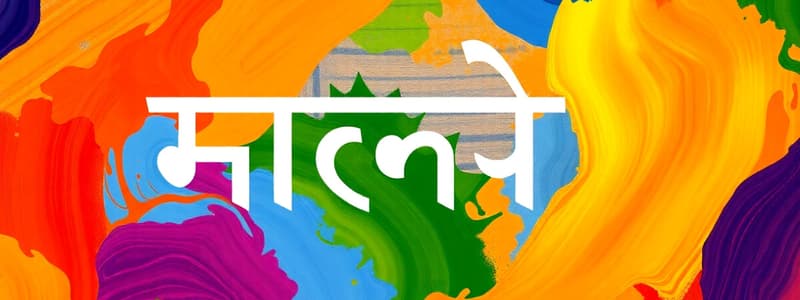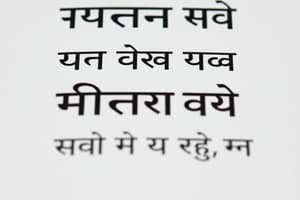Podcast
Questions and Answers
Which historical period primarily accounts for the introduction of common Hindi words from Persian and Arabic?
Which historical period primarily accounts for the introduction of common Hindi words from Persian and Arabic?
- The Vedic Period
- The Mauryan Empire
- The British Colonial Era
- The Mughal Period (correct)
In Hindi grammar, adjectives must agree with the nouns they modify in:
In Hindi grammar, adjectives must agree with the nouns they modify in:
- Mood and voice
- Case and tense
- Gender and number (correct)
- Tense and aspect
Which historical influence primarily shaped the development of Hindustani during the Delhi Sultanate and Mughal Empire?
Which historical influence primarily shaped the development of Hindustani during the Delhi Sultanate and Mughal Empire?
- Sanskrit
- Persian and Arabic (correct)
- English
- Prakrit
Khariboli is the foundational dialect for which form of Hindi?
Khariboli is the foundational dialect for which form of Hindi?
Who is widely regarded as the 'father of modern Hindi literature'?
Who is widely regarded as the 'father of modern Hindi literature'?
What was the main focus of efforts to standardize Hindi in the 19th century, distinguishing it from Urdu?
What was the main focus of efforts to standardize Hindi in the 19th century, distinguishing it from Urdu?
What role does 'Sanskritization' play in the evolution of the Hindi language?
What role does 'Sanskritization' play in the evolution of the Hindi language?
Which characteristic of the Devanagari script is essential for understanding how Hindi is written?
Which characteristic of the Devanagari script is essential for understanding how Hindi is written?
Which of the following linguistic features is characteristic of Hindi grammar?
Which of the following linguistic features is characteristic of Hindi grammar?
How has Hindi cinema (Bollywood) most significantly influenced Indian culture?
How has Hindi cinema (Bollywood) most significantly influenced Indian culture?
What is one of the primary challenges Hindi faces in contemporary India?
What is one of the primary challenges Hindi faces in contemporary India?
In what way do loanwords typically adapt when integrated into the Hindi language?
In what way do loanwords typically adapt when integrated into the Hindi language?
Which grammatical feature is indicated by verb conjugations in Hindi?
Which grammatical feature is indicated by verb conjugations in Hindi?
Which of the following statements accurately describes the relationship between Modern Standard Hindi and Hindustani?
Which of the following statements accurately describes the relationship between Modern Standard Hindi and Hindustani?
Which of these regions has the smallest proportion of Hindi speakers relative to its total population?
Which of these regions has the smallest proportion of Hindi speakers relative to its total population?
What is the most accurate description of the word order that Hindi follows in sentence construction?
What is the most accurate description of the word order that Hindi follows in sentence construction?
Flashcards
Sanskrit's Role in Hindi
Sanskrit's Role in Hindi
The source of much formal and technical vocabulary in Hindi.
Persian and Arabic Influence
Persian and Arabic Influence
Common words entered Hindi during the Mughal empire.
Sanskritization
Sanskritization
Creating new Hindi words from Sanskrit roots to replace loanwords.
Noun Cases in Hindi
Noun Cases in Hindi
Signup and view all the flashcards
Verb Conjugations
Verb Conjugations
Signup and view all the flashcards
Gender Agreement
Gender Agreement
Signup and view all the flashcards
Khariboli's Importance
Khariboli's Importance
Signup and view all the flashcards
Hindi's Influence
Hindi's Influence
Signup and view all the flashcards
What is Hindi?
What is Hindi?
Signup and view all the flashcards
Origin of the name 'Hindi'
Origin of the name 'Hindi'
Signup and view all the flashcards
Khariboli
Khariboli
Signup and view all the flashcards
Origin of Old Hindi
Origin of Old Hindi
Signup and view all the flashcards
Influences on Hindi
Influences on Hindi
Signup and view all the flashcards
Standardization of Hindi
Standardization of Hindi
Signup and view all the flashcards
Devanagari
Devanagari
Signup and view all the flashcards
Hindi word order
Hindi word order
Signup and view all the flashcards
Study Notes
- Hindi is an Indo-Aryan language spoken chiefly in India
- It is the official language of the Union government of India
- Hindi is one of the 22 scheduled languages of India
- The name "Hindi" is derived from the Persian word "Hind," meaning "land of the Indus River"
- Modern Standard Hindi is based on the Khariboli dialect
- It is mutually intelligible with Hindustani
History
- Old Hindi evolved from Apabhramsa, a descendant of Prakrit languages
- By the 13th century, Old Hindi had emerged as a distinct linguistic entity
- During the Delhi Sultanate and Mughal Empire, Hindi was influenced by Persian, Arabic, and Turkic languages, leading to the development of Hindustani
- In the 19th century, efforts were made to standardize Hindi as a distinct language from Urdu, focusing on Sanskritization and the removal of Persian and Arabic loanwords
- Bharatendu Harishchandra played a significant role in modernizing Hindi literature
- In 1950, Hindi written in Devanagari script was declared as the official language of the Union government of India
Geographical Distribution
- Hindi is primarily spoken in the Hindi Belt region of India, including states like Uttar Pradesh, Madhya Pradesh, Bihar, Haryana, Rajasthan, Uttarakhand, Chhattisgarh, Himachal Pradesh, Jharkhand, and Delhi
- Significant Hindi-speaking populations are also found in other parts of India, such as Maharashtra, Gujarat, and West Bengal
- Outside India, Hindi speakers exist in countries like Nepal, Mauritius, Fiji, South Africa, Suriname, Trinidad and Tobago, and the United States
Writing System
- Hindi is written in the Devanagari script
- Devanagari is an abugida script, where each consonant has an inherent vowel
- Vowels can be written as independent letters or as diacritics modifying consonants
- The script is written from left to right
- Devanagari is also used for other languages, including Sanskrit, Marathi, and Nepali
Linguistic Features
- Hindi is an Indo-Aryan language, closely related to other languages like Urdu, Punjabi, Bengali, and Gujarati
- Hindi grammar includes a system of noun cases, verb conjugations, and gender agreement
- Hindi has a subject-object-verb (SOV) word order
- Postpositions are used instead of prepositions
- Hindi vocabulary includes words of Sanskrit, Persian, Arabic, and English origin
- Loanwords are often nativized to fit the phonological and morphological patterns of Hindi
Vocabulary
- Hindi vocabulary is derived from Sanskrit, Prakrit, Persian, Arabic, and English
- Sanskrit provides a large portion of the formal and technical vocabulary
- Persian and Arabic contributed many common words during the Mughal period
- English has contributed numerous modern and technical terms
- The process of Sanskritization involves creating new Hindi words from Sanskrit roots to replace loanwords
Grammar
- Hindi grammar includes noun cases, verb conjugations, gender agreement, and postpositions
- Nouns are marked for case, gender (masculine and feminine), and number (singular and plural)
- Verb conjugations indicate tense, aspect, mood, gender, and number
- Gender agreement requires that adjectives and verbs agree in gender and number with the nouns they modify
- Postpositions follow the noun they govern and indicate relationships such as location, direction, and possession
Dialects
- Hindi has several dialects, which can be broadly categorized into Western Hindi and Eastern Hindi
- Western Hindi dialects include Khariboli, Braj Bhasha, Haryanvi, Bundeli, and Kannauji
- Eastern Hindi dialects include Awadhi, Bagheli, and Chhattisgarhi
- Khariboli serves as the basis for Modern Standard Hindi
- Dialectal variations exist in pronunciation, vocabulary, and grammar
Literature
- Hindi literature has a rich history, spanning from medieval devotional poetry to modern novels and dramas
- Prominent medieval poets include Kabir, Tulsidas, and Surdas
- Bharatendu Harishchandra is considered the father of modern Hindi literature
- Major modern writers include Premchand, Jaishankar Prasad, and Mahadevi Varma
- Hindi literature reflects the socio-cultural and political changes in India
Influence on Other Languages and Culture
- Hindi has influenced other languages, particularly through loanwords and cultural exchange
- Many Hindi words have been adopted into English and other languages
- Hindi cinema (Bollywood) has a significant impact on Indian culture and is popular worldwide
- Hindi songs and films have contributed to the spread of Hindi language and culture
- Hindi is used extensively in media, including newspapers, television, and radio
Current Status and Challenges
- Hindi is one of the most widely spoken languages in the world
- It faces challenges related to standardization, language policy, and promotion
- The promotion of Hindi as the official language has been controversial in some parts of India, particularly in South India, where Dravidian languages are spoken
- Efforts are being made to develop Hindi as a language of science, technology, and administration
- The use of Hindi on the internet and in digital media is growing
Studying That Suits You
Use AI to generate personalized quizzes and flashcards to suit your learning preferences.




